For over 200 years, gundalows – sail and oar powered cargo barges – moved on the winds and tides of the rivers and estuaries along the New England coast. Yesterday, the brand new gundalow, Piscataqua, splashed into the the Piscataqua River off Peirce Island, in Portsmouth, New Hampshire. The new gundlow was built by the Gundlow Company, a nonprofit organization founded in 2002 to acquire ownership of an existing gundalow — the Captain Edward H. Adams, built in 1982 and named in honor of the builder and captain of the last commercial gundalow. The Captain Edward H. Adams was not licensed to carry passengers, so the gundalow Piscataqua was built, which is Coast Guard certified to carry 49 passengers. The Gudalow Company plans a variety of sailing programs to help educate students and adults in the maritime heritage of the region while also focusing on contemporary coastal issues such as water quality, habitat restoration, conservation, and stewardship.
 After being gutted by fire in 2007, the 1869 composite tea clipper Cutty Sark has been undergoing a methodical reconstruction. She reached a milestone recently when her foremast was restepped in the ship. The main and mizzen masts are expected to be stepped this weekend. The Cutty Sark is a composite ship in that she has wooden planking but iron frames and keel. Ironically, the ship was almost destroyed during a restoration project when an industrial vacuum cleaner caught fire. The Cutty Sark will be officially reopened by the Queen in late April. Thanks to Alaric Bond for passing the news along.
After being gutted by fire in 2007, the 1869 composite tea clipper Cutty Sark has been undergoing a methodical reconstruction. She reached a milestone recently when her foremast was restepped in the ship. The main and mizzen masts are expected to be stepped this weekend. The Cutty Sark is a composite ship in that she has wooden planking but iron frames and keel. Ironically, the ship was almost destroyed during a restoration project when an industrial vacuum cleaner caught fire. The Cutty Sark will be officially reopened by the Queen in late April. Thanks to Alaric Bond for passing the news along.
Cutty Sark in Greenwich has restored masts raised
Cutty Sark’s masts raised (Youtube video)
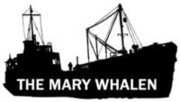 Yesterday we posted about the New York Police Department Harbor Unit’s use of ROVs to maintain security in the harbot. We had missed an amusing post by Portside New York‘s Carolina Salguero on NPYD security training on the MARY A. WHALEN. From her post:
Yesterday we posted about the New York Police Department Harbor Unit’s use of ROVs to maintain security in the harbot. We had missed an amusing post by Portside New York‘s Carolina Salguero on NPYD security training on the MARY A. WHALEN. From her post:
The NYPD trained officers on how to use the new cameras on the MARY A. WHALEN during May of 2007.
An NYPD boat came along side, and an officer in sunglasses skipped over introductions and said “can we look at your bottom with an underwater camera?”
I said, “I don’t show my bottom to just any guy… who’s asking?”
Without the hint of a laugh, Detective Keith Duval handed over a card and said he was with the Counter Terrorism Division.
Continue reading
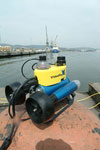 New York harbor was the sight of the first use of a submersible in combat. On September 6, 1776, Eza Lee in command of the Turtle, a one man submersible designed by David Bushnell, attempted and failed to sink Admiral Richard Howe’s flagship HMS Eagle. Today, modern submersibles are watching out for new underwater threats in the harbor.
New York harbor was the sight of the first use of a submersible in combat. On September 6, 1776, Eza Lee in command of the Turtle, a one man submersible designed by David Bushnell, attempted and failed to sink Admiral Richard Howe’s flagship HMS Eagle. Today, modern submersibles are watching out for new underwater threats in the harbor.
The New York Police Department Harbor Unit now has at least six unmanned submersible drones, remote-operated vehicles, or R.O.Vs, to search the harborside and hulls of ships for explosives, weapons or narcotics. The mission of the Harbor Unit has increasingly shifted to counter-terrorism and the drones have provided a new set of eyes to search for threats below the tide line.
Underwater Drones Giving More Eyes to Police Harbor Unit as Searches Grow
Continue reading
Track of the Banque Populaire V in purple, track of current record holder Groupma in green
Last February the crew of the 130′ long by 120′ wide maxi-trimaran Banque Populaire V was forced to give up their attempt to the win the Jules Verne trophy for the fastest circumnavigation by sail when the trimaran struck an “unidentified floating object” while traveling at 37 knots, severely damaging a dagger board. On November 22, 2011, the Banque Populaire V set out again and has had much better fortune. After only 18 days, the big tri has sailed past Spain, down the South Atlantic, around the Cape of Good Hope, across the Indian Ocean and now has cross the longitude of Cape Leeuwin, Australia. They are currently almost four days and 2000 miles ahead of the position of the current record holder, the French trimaran Groupama 3,
HMS Ocean, a Royal Navy amphibious assault ship, had planned for a seven week deployment but was diverted to Libya and ended up being away for 225 days with 176 at sea. When they received word that they would be back in time for Christmas, they made this video of a Mariah Carey song.
 Within hours of the tsunami that struck northern Japan last March, the internet was abuzz with the somewhat bizarre suggestion that the earthquake and wave which followed might be some sort of cosmic retribution for Japanese whaling. Regardless of what one thinks of that suggestion, the Japanese whaling industry was hard hit by the tsunami. Several villages, for which whaling had traditionally been their major industry, were virtually wiped out. Japanese Town Mulls Future Without Whaling Industry
Within hours of the tsunami that struck northern Japan last March, the internet was abuzz with the somewhat bizarre suggestion that the earthquake and wave which followed might be some sort of cosmic retribution for Japanese whaling. Regardless of what one thinks of that suggestion, the Japanese whaling industry was hard hit by the tsunami. Several villages, for which whaling had traditionally been their major industry, were virtually wiped out. Japanese Town Mulls Future Without Whaling Industry
Nevertheless, the Japanese intend to continue what they refer to as “research whaling.” This year, they plan on harvesting up to 900 whales, primarily minkes, which are not endangered. The announcement that the government of Japan is providing the whalers with 2.28 billion yen ($37.6 million) from funds set aside for tsunami recovery has led to protests, within Japan and internationally. Japan uses disaster funds for whaling
Continue reading
 Last April, Commander Etta Jones was relieved of duty as captain of the amphibious transport dock ship USS Ponce. The Ponce‘s executive officer, Lt. Cmdr. Kurt Boenisch, was also relieved. A Navy report examining allegations made against Commander Jones substantiated the charges. She was found to be verbally abusive, to have given preferential treatment to female officers, and to have allowed hazing aboard ship, among other charges. The full report can be found here.
Last April, Commander Etta Jones was relieved of duty as captain of the amphibious transport dock ship USS Ponce. The Ponce‘s executive officer, Lt. Cmdr. Kurt Boenisch, was also relieved. A Navy report examining allegations made against Commander Jones substantiated the charges. She was found to be verbally abusive, to have given preferential treatment to female officers, and to have allowed hazing aboard ship, among other charges. The full report can be found here.
Continue reading

Last Sunday we posted about the CBC program,Land and Sea, which was broadcasting a half hour documentary on traditional schooners in Nova Scotia. It is now available to watch on-line. The documentary tells the story of four different schooner owners and reveals how each of them is keeping the spirit of these majestic sailing vessels alive. If you are schooner fan, definitely worth a look. Click here to watch Schooners.
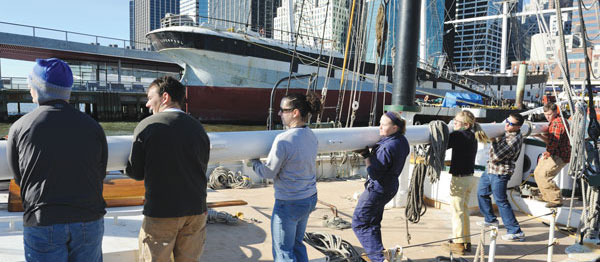 Several years ago I took a sail on the AJ Meerwald in New York harbor. While on the sail I saw the schooner Pioneer, owned and operated by the South Street Seaport Museum, also sailing in the harbor. Despite having lived in and around New York harbor for decades, I knew nothing about the Pioneer. I asked the mate on the Meerwald what she knew of the schooner. She said something to the effect that they had a fantastic group of volunteers but that the museum management did a lousy job of promoting the schooner.
Several years ago I took a sail on the AJ Meerwald in New York harbor. While on the sail I saw the schooner Pioneer, owned and operated by the South Street Seaport Museum, also sailing in the harbor. Despite having lived in and around New York harbor for decades, I knew nothing about the Pioneer. I asked the mate on the Meerwald what she knew of the schooner. She said something to the effect that they had a fantastic group of volunteers but that the museum management did a lousy job of promoting the schooner.
Unfortunately that never changed. The South Street Seaport Museum continued to have a loyal and hardworking group of volunteers, while the museum management continued to do a lousy job. This continued until last February when the museum collapsed financially, staff was laid off and the volunteers were turned away.
An interesting thing happened. A group of volunteers formed Save Our Seaport and turned their energies toward saving the museum – holding public meetings circulating petitions and doing all they could to save an institution so badly served by past managers. The good news is that the museum has been taken over by the Museum of New York and last weekend, the volunteers were allowed back in. Forty five people assembled on Pier 16 and got to work moving spars and cleaning up debris.. There could be no clearer sign that the South Street Seaport Museum is on its way back.
 We seem to need to put a face to our enemies. On the cover of Time Magazine of December 22, 1941, the face of the enemy was Admiral Yamamoto, labeled as “Japan’s Aggressor.” The image of the admiral is a scowling caricature in yellow, looking off to one side, personifying an image of Oriental duplicity and betrayal. In the decades following the war, historians have been far more charitable to Isoroku Yamamoto, casting him as a reluctant warrior who understood and predicted Japan’s defeat even while personally planning the attack on Pear Harbor. Ian Toll’s A Reluctant Enemy in today’s New York Times makes this case. I wonder whether this assessment of Yamamoto is not, at times, almost as a much a caricature as the Time magazine cover of 1941.
We seem to need to put a face to our enemies. On the cover of Time Magazine of December 22, 1941, the face of the enemy was Admiral Yamamoto, labeled as “Japan’s Aggressor.” The image of the admiral is a scowling caricature in yellow, looking off to one side, personifying an image of Oriental duplicity and betrayal. In the decades following the war, historians have been far more charitable to Isoroku Yamamoto, casting him as a reluctant warrior who understood and predicted Japan’s defeat even while personally planning the attack on Pear Harbor. Ian Toll’s A Reluctant Enemy in today’s New York Times makes this case. I wonder whether this assessment of Yamamoto is not, at times, almost as a much a caricature as the Time magazine cover of 1941.
Continue reading
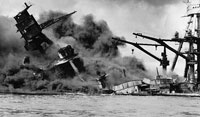 It was inevitable. The Pearl Harbor Survivors Association will observe the 70th anniversary of the attack on Pearl Harbor on this day in 1941. It will be the Association’s last observance. The group has too few remaining members to carry on and will disband on Dec. 31. The organization was founded in 1958 with 28,000 members, all of whom were were at or in the vicinity of Pearl Harbor, Hawaii during the Japanese attack of December 7, 1941. The association now has fewer than 10% of it original numbers and the continuing death toll due to age continues to reduce the number of survivors. Twenty years ago at the 50th anniversary, 7,000 survivors attended the memorial ceremonies. This year roughly 125 are expected to be able to attend.
It was inevitable. The Pearl Harbor Survivors Association will observe the 70th anniversary of the attack on Pearl Harbor on this day in 1941. It will be the Association’s last observance. The group has too few remaining members to carry on and will disband on Dec. 31. The organization was founded in 1958 with 28,000 members, all of whom were were at or in the vicinity of Pearl Harbor, Hawaii during the Japanese attack of December 7, 1941. The association now has fewer than 10% of it original numbers and the continuing death toll due to age continues to reduce the number of survivors. Twenty years ago at the 50th anniversary, 7,000 survivors attended the memorial ceremonies. This year roughly 125 are expected to be able to attend.
Pearl Harbor Still a Day for the Ages, but a Memory Almost Gone
Seventeen teams from around the world have set off rowing from Spain’s San Sebastian de la Gomera in the Canary Islands in the Talisker Whisky Atlantic Challenge in what is billed as the “World’s Roughest Rowing Race.” The teams will follow the ‘Columbus Route’ westbound across the mid-Atlantic to Port St Charles in Barbados, rowing an estimated 3,000 miles over roughly 50 days. There are two solo rowers and fifteen two, four or six person crews.
[iframe: src=”http://player.vimeo.com/video/33213622?title=0&byline=0&portrait=0″ width=”400″ height=”225″ frameborder=”0″ webkitAllowFullScreen mozallowfullscreen allowFullScreen]
RACE LAUNCH from Talisker Whisky on Vimeo.
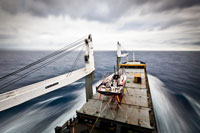
PUMA's Mar Mostro traveling by ship to Cape Town after dismasting. Photo: Amory Ross/PUMA Ocean Racing/Volvo Ocean Race
I was struck by the juxtaposition. Laura Dekker, the Dutch 16 year old who is sailing around the world alone, arrived in Cape Town at roughly the same times as the mega-racers of the Volvo Ocean Race. Well, she arrived at the same time as the three boats that held together long enough to make it Cape Town. The other half of the Volvo Ocean Race fleet traveled by ship to South Africa after rigging or hull failure temporarily put them out of the race.
Continue reading
 Perhaps Miami Beach is feeling a certain solidarity with Koblentz, Germany. Today an M57 US Navy training mine washed up on Miami Beach. Fortunately the mine was inert and did not contain explosive. Yesterday, bomb disposal experts successfully defused two World War II vintage bombs which had become exposed on the Rhine riverbanks at Koblentz, when water levels dropped due to an ongoing drought.
Perhaps Miami Beach is feeling a certain solidarity with Koblentz, Germany. Today an M57 US Navy training mine washed up on Miami Beach. Fortunately the mine was inert and did not contain explosive. Yesterday, bomb disposal experts successfully defused two World War II vintage bombs which had become exposed on the Rhine riverbanks at Koblentz, when water levels dropped due to an ongoing drought.
We have previously posted about how the European drought has lowered the Rhine River so that World War II munitions long buried in the riverbank have become exposed. Over the weekend, forty five thousand people, roughly half of the population of the city of Koblentz, Germany, at the junction of the Rhine and Moselle Rivers, were evacuated in order to defuse bombs exposed by falling river levels. Initially, it was reported that one British 4,000 pound bomb would be defused. Now, it appears that that bomb, as well as a smaller American high explosive bomb were both defused. A third non-explosive device was also destroyed, according to the Koblenz fire department.
WWII bombs defused allowing 45,000 evacuated residents to return
On Friday, the “Christmas Tree Ship” arrived again on the Chicago docks, bringing Christmas trees to needy families. The arrival of the ship has become a Chicago holiday tradition, honoring of the memory of Capt Herman Schuenemann and his three masted schooner, the Rouse Simmons, known to many as the “Christmas Tree ship,” which delivered Christmas trees to the Chicago Docks for over 30 years around the turn of the 20th century. Starting in 2000, the maritime community of Chicago has revived the tradition. This year, the US Coast Guard Cutter Alder arrived at the dock, her decks loaded with trees, which are being distributed to local families over the weekend.
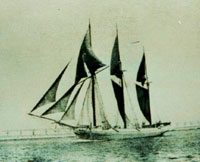
Schooner Rouse Simmons
Today the Christmas Ship is Chicago’s largest all volunteer charitable support program for inner city youth and their families at Christmas time. At the turn of the twentieth century, the “Christmas Tree Ship” was a family business. In the mid 1880s, August and his brother Herman Schuenemann moved to Chicago. They were merchants and sailors who made two-thirds of their annual income transporting and selling Christmas trees. August died in in November 1898 when the two-masted schooner S. Thal sank in a storm near Glencoe, Illinois. His younger brother Herman continued the family business.
Continue reading
In the United States, we have seen an explosion of so-called “reality TV,” which is usually more akin to unscripted soap opera than reality, fortunately. In Canada, however, the CBC has some wonderful programming which is reality television in the very best sense. On fine example is “Land and Sea,” a program which for thirty years has been focussed on stories from people who live off the land and the sea on the Canadian Atlantic. Today, at noon, it will feature, “Schooners,” a look at the schooners of Nova Scotia. For those of us who not live in Canada, the program will be available on-line here. Here also are comments from the director of the documentary.
Thanks to Tom Russell fro pointing out the Director’s Cut on the Traditional Sail Professionals Linked-in List.
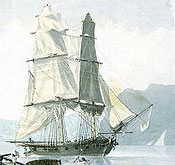
HMS Speedy - Dr. James Guthrie, commander and crew, albeit briefly
On Facebook this morning, Maritime Great Britain linked to a post on THE DEAR SURPRISE blog, discussing a post by Marion Elizabeth Diamond on the Historians are Past Caring blog, which raised the question, “Was this the real Stephen Maturin?” Ms. Diamond answers her own question with the suggestion that Patrick O’Brian may have based his character of ships’ surgeon/spy, Stephen Maturin, on the doctor and scientist, Augustus Bozzi Granville, who did indeed serve in the medical service of the Royal Navy.
Bozzi Geneville may indeed have served as an inspiration to O’Brian. I have always thought that O’Brian borrowed from the life of Joseph Banks for both his characters, Maturin and Joseph Blaine. Bozzi Geneville looks like a reasonable candidate, as well. Nevertheless, we should not forget Dr. James Guthrie, who provided the very literal inspiration for O’Brian’s Dr. Maturin.
Continue reading
